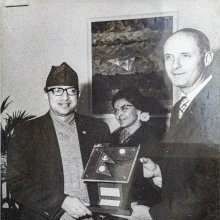Candraloka, Candra-loka, Camdraloka: 9 definitions
Introduction:
Candraloka means something in Hinduism, Sanskrit. If you want to know the exact meaning, history, etymology or English translation of this term then check out the descriptions on this page. Add your comment or reference to a book if you want to contribute to this summary article.
Alternative spellings of this word include Chandraloka.
Images (photo gallery)
In Hinduism
Purana and Itihasa (epic history)
Source: Cologne Digital Sanskrit Dictionaries: The Purana IndexCandraloka (चन्द्रलोक).—Attained by those who observe RohiṇīCandraśayana vratam.*
- * Matsya-purāṇa 57. 26; 193. 76.

The Purana (पुराण, purāṇas) refers to Sanskrit literature preserving ancient India’s vast cultural history, including historical legends, religious ceremonies, various arts and sciences. The eighteen mahapuranas total over 400,000 shlokas (metrical couplets) and date to at least several centuries BCE.
Languages of India and abroad
Sanskrit dictionary
Source: DDSA: The practical Sanskrit-English dictionaryCandraloka (चन्द्रलोक).—the world of the moon.
Derivable forms: candralokaḥ (चन्द्रलोकः).
Candraloka is a Sanskrit compound consisting of the terms candra and loka (लोक).
Source: Cologne Digital Sanskrit Dictionaries: Shabda-Sagara Sanskrit-English DictionaryCandraloka (चन्द्रलोक).—n.
(-kaṃ) The sphere or heaven of the moon. E. candra and loka world.
Source: Cologne Digital Sanskrit Dictionaries: Aufrecht Catalogus Catalogorum1) Candrāloka (चन्द्रालोक) as mentioned in Aufrecht’s Catalogus Catalogorum:—alaṃk. by Jayadeva, son of Mahādeva. L. 605. 772. 1784. B. 3, 52. Report. Xvi. Ben. 38. Kāṭm. 8 (and—[commentary]). Pheh. 6. 15. Rādh. 24 (and—[commentary]). Oudh. V, 10. Xiv, 44. Xviii, 34. Burnell. 55^b. Poona. 568. Taylor. 1, 6. 282. Oppert. 549. 855. 893. 979. 1818. 1819. 2177. 3125. 3974. 5966. 6579. 7945. Ii, 685. 1318. 1747. 1748. 2428. 2718. 2926. 3142. 3638. 5672. 6900. 7257. 8209. 8843. 9027. Rice. 284. Peters. 2, 109. Bp. 265. Bühler 543. Served as a model for the Kuvalayānanda.
—[commentary] Candrālokapradīpikā. NW. 614.
—[commentary] Candrālokaprakāśa Śaradāgama by Pradyotana Bhaṭṭa. L. 1748. K. 106. Report. Xvi, Oudh. Xviii, 34. Lahore. 8. Bhk. 29. Bühler 543.
—[commentary] by Vājacandra. K. 100.
—[commentary] Rākāgama by Viśveśvara. Oudh. Viii, 12. Lahore. 8. Peters. 2, 109.
—[commentary] Harilocanacandrikā by Vaidyanātha Pāyaguṇḍe. K. 100. Report. Xvi. NW. 608. Rice. 284. Sb. 301 (Ramā).
2) Candrāloka (चन्द्रालोक):—add Io. 2656.
—[commentary] by Pradyotana. add B. C¤, 52. Oudh. V 6 Oppert. 8279. read L. 1784.
—[commentary] by Viśveśvara. add L. 3101 (called here Sudha).
3) Candrāloka (चन्द्रालोक):—alaṃk. by Jayadeva, son of Mahādeva. Gov. Or. Libr. Madras 26. Oudh. Xxi, 78. Peters. 4, 26. Rgb. 529. Stein 62.
—[commentary] Śaradāgama by Pradyotana Bhaṭṭa. Fl. 467. Oudh. Xxi, 78. Stein 62.
—[commentary] Rākāgama by Viśveśvara. Gov. Or. Libr. Madras 26.
—[commentary] by Vaidyanātha Pāyaguṇḍa. Stein 62 (Ramā).
4) Candrāloka (चन्द्रालोक):—alaṃk. by Jayadeva, son of Mahādeva. Ulwar 1057.
—[commentary] Candrālokaprakāśa or Śaradāgama by Pradyotana Bhaṭṭa, son of Miśra Balabhadra. ibid.
5) Candrāloka (चन्द्रालोक):—alaṃk. different from the preceding, and later. No proper description given. Ulwar 1058.
—[commentary] Ulwar 1059.
6) Candrāloka (चन्द्रालोक):—alaṃk. by Jayadeva, son of Mahādeva. Bd. 590. Hz. 848. L.. 819 (1-5). 820 (till 5, 58). Peters. 5, 410. 411. C. Candrālokaprakāśa Śaradāgama, composed in 1583 by Pradyotana Bhaṭṭācārya, son of Balabhadra. L.. 820 (till 5, 58).
Source: Cologne Digital Sanskrit Dictionaries: Monier-Williams Sanskrit-English Dictionary1) Candraloka (चन्द्रलोक):—[=candra-loka] [from candra > cand] m. [plural] the worlds or spheres of the moon, [Śatapatha-brāhmaṇa xiv] (cf. candrādi-l.)
2) Candrāloka (चन्द्रालोक):—[from candra > cand] m. Name of [work] on rhetoric by Jaya-deva.
Source: Cologne Digital Sanskrit Dictionaries: Yates Sanskrit-English DictionaryCandraloka (चन्द्रलोक):—[candra-loka] (kaṃ) 1. n. Moon’s sphere.
[Sanskrit to German]
Sanskrit, also spelled संस्कृतम् (saṃskṛtam), is an ancient language of India commonly seen as the grandmother of the Indo-European language family (even English!). Closely allied with Prakrit and Pali, Sanskrit is more exhaustive in both grammar and terms and has the most extensive collection of literature in the world, greatly surpassing its sister-languages Greek and Latin.
Kannada-English dictionary
Source: Alar: Kannada-English corpusCaṃdralōka (ಚಂದ್ರಲೋಕ):—
1) [noun] the moon and its environment.
2) [noun] the heaven of the moon.
--- OR ---
Caṃdrālōka (ಚಂದ್ರಾಲೋಕ):—[noun] the luster of the moon.
Kannada is a Dravidian language (as opposed to the Indo-European language family) mainly spoken in the southwestern region of India.
See also (Relevant definitions)
Partial matches: Loka, Candra.
Starts with: Candralokana.
Full-text (+35): Camdrabhuvana, Jayadeva, Induloka, Candravrata, Candramasaloka, Aloka, Appayyadikshita, Candratirtha, Sharadasharvari, Phalguna, Vidyabhushana, Virodha, Danam, Baladeva, Chekapahnuti, Vrittyanuprasa, Gumpha, Virodhabhasa, Guptotpreksha, Vinokti.
Relevant text
Search found 15 books and stories containing Candraloka, Camdraloka, Caṃdralōka, Caṃdrālōka, Candra-loka, Candra-lōka, Candrāloka, Candralōka, Candrālōka; (plurals include: Candralokas, Camdralokas, Caṃdralōkas, Caṃdrālōkas, lokas, lōkas, Candrālokas, Candralōkas, Candrālōkas). You can also click to the full overview containing English textual excerpts. Below are direct links for the most relevant articles:
Kavyamimamsa of Rajasekhara (Study) (by Debabrata Barai)
Part 2 - Alaṃkāra theory and position of the Kāvyamīmāṃsā < [Chapter 4 - Position of the Kāvyamīmāṃsā in Sanskrit Poetics]
Part 16 - Citramīmāṃsā, Kuvalayānanda and Vṛttavārtika of Appayadīkṣita < [Chapter 2 - A General Outlines of Sanskrit Poetics]
Alamkaras mentioned by Vamana (by Pratim Bhattacharya)
17: Alaṃkāra-śāstra according to Jayadeva (12th century) < [Chapter 2 - The concept of alaṃkāra in Sanskrit Poetics]
23: Alaṃkāra-śāstra according to Appayya Dīkṣita (16th Century) < [Chapter 2 - The concept of alaṃkāra in Sanskrit Poetics]
28: Definition of Samāhita Alaṃkāra < [Chapter 4 - Arthālaṃkāras mentioned by Vāmana]
Sahitya-kaumudi by Baladeva Vidyabhushana (by Gaurapada Dāsa)
Text 11.51 < [Chapter 11 - Additional Ornaments]
Text 10.88 < [Chapter 10 - Ornaments of Meaning]
Text 11.38 [Pūrva-rūpa] < [Chapter 11 - Additional Ornaments]
Mudrarakshasa (literary study) (by Antara Chakravarty)
1. Meaning and importance of Alaṃkāra < [Chapter 3 - Use of Alaṃkāras in Mudrārākṣasa]
2. Classification and number of Alaṃkāras < [Chapter 3 - Use of Alaṃkāras in Mudrārākṣasa]
The Agni Purana (by N. Gangadharan)
The Devi Bhagavata Purana (by Swami Vijñanananda)
